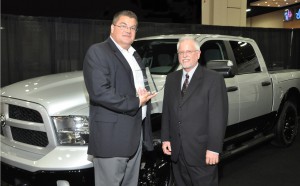American motorists have a particularly good reason to celebrate the New Year, unleaded regular gasoline averaging barely $2.40 a gallon across the country, according to federal data, as low as the price has been in more than half a decade.
But not everyone is sharing in the good news. The relatively small number of motorists – along with the nation’s truckers — who depend on diesel are paying an average of $3.28 a gallon, according to the most recent survey by the Energy Information Administration. That figure did mark a decline of nearly 60 cents since the beginning of 2014, but was nowhere near the 87-cent plunge in gas prices.
And there are signs that the widening cost gap is starting to short circuit the nascent comeback of the diesel market. Demand for so-called clean diesels had been growing a significantly faster rate than the overall U.S. automotive recovery through mid-2014, but sales are beginning to slip as lower gas prices offset the higher mileage diesels offer.
“It’s too early to call it a trend,” but there are clear signs of weakness in diesel sales, said Dave Sullivan, senior automotive analyst with AutoPacific, Inc.
(The old year ends with a recall – and 2015 begins with a new recall. Click Here for more.)
Volkswagen, the largest player in the segment, has seen diesels dip to less than 20% of its overall U.S. sales mix, down from more than 25% early in the year.
Sales of diesel-powered vehicles had been on a clear upswing after virtually disappearing in the late 1980s and ‘90s. For the first six months of 2014, in fact, diesel sales had surged a full 25% year-over-year, compared to a 4% upturn in the overall American automotive market. And hybrid vehicles had posted a nearly double-digit decline during the same time period.
That had spurred a sharp growth in the number of new diesel models. Audi, for example, brought out three new “oil-burners” for 2014 and another for the current model-year. Chevrolet launched its first diesel-powered passenger car in decades, a version of the Chevrolet Cruze. Chrysler – recently renamed FCA US – added the Ram EcoDiesel pickup, winning over new buyers and a number of prestigious awards.
Not everyone was convinced that diesel would become the industry’s next big thing. Ford, for one, said it wasn’t convinced diesel would offer any real advantage over the turbocharged EcoBoost engines that have been proliferating across its passenger car and light truck line-up.
That is beginning to look like a wise decision, several observers said. But the real question is whether the gap that has opened between gas and diesel fuel will continue to widen, and if so, for how long?
(List of “safest” cars nearly doubles for 2015, according to IIHS. Click Here for the latest.)
Diesel has traditionally been more expensive, though usually only by a quarter to 50 cents, depending on the individual state. But in recent days, some Michigan stations have been marketing gasoline for as little as $1.90 a gallon even while charging more than $3.20 for a gallon of diesel.
Local tax policies make up a small part of that gap – some states aiming to recover higher road maintenance costs attributed to heavy truck traffic. Another factor is that the U.S. now exports a significant portion of the diesel fuel it produces, much of it to Europe where diesel vehicles account for nearly half of all sales.
According to the American Trucking Association, the U.S. is now exporting ten times as much diesel as it did a decade ago.
And there’s other competition for the fuel. Refineries crack crude petroleum into a number of different distillates, but they have to choose whether to produce more diesel or more home heating oil.
“A severe cold snap could push prices up” for diesel motorists, warned analyst Sullivan.
The auto industry will release December sales figures next Monday and they very well may show a dip in diesel sales. Whether that becomes a long-term trend will become more apparent in the months ahead.
(New study forecasts conventional gas-powered cars will be in the global minority by 2017. Click Here for the full story.)



After paying $3.50-$4.20/gallon for diesel for so long, I’ll take the $2.99/gallon I paid for my most recent tank, thank you very much.
I suspect the fact that truck freight is staying strong has something to do with more demand for diesel than gas.
It’s the same old manipulation of prices by the oil industry Cabal. It’s totally absurd for Diesel prices to be higher than gas prices when there is less refining costs for Diesel. It’s all just a game.
It’s capitalism, folks. In almost all the rest of the world, diesel is cheaper than gasoline. But in the US, most diesel is sold into an “ineleastic” market. Diesel trucks and trains have to go, whatever the price of fuel. We don’t have the 55-80% of vehicles burning diesel many European cities have.
It’s not capitalism, it’s an industry monopoly that dictates price. It’s time to bring back to the U.S. the excess profit tax for oil companies…
A Prius owner, there is no joy with diesel sales being hit by the fuel price differential. Our common goal is a more fuel efficient fleet and diesels are another approach . . . not that I am tempted to switch from a Prius with even cheaper fuel.
I’m more tempted by a used Leaf to cut my daily driving cost in half again and using our Prius for long distance trips. The irony is having a Leaf would make a Golf TDI or even Passat a feasible alternative for the cross-country Prius until we see the diesel fuel price premium. Diesel engine efficiency does not compensate for the price differential over a Prius. It may work against an ordinary gasser but the margin is very narrow.
Bob Wilson